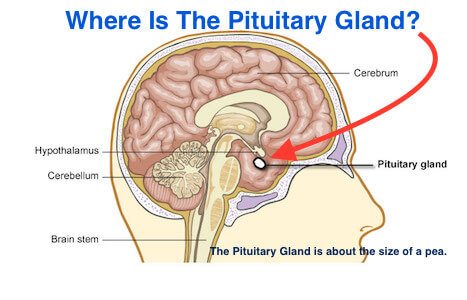What is Sheehan’s Syndrome?
The rare disease Sheehan’s Syndrome is a disease that affects the function of the pituitary gland and is caused by severe blood loss during or after childbirth. The loss of blood to the pituitary gland may destroy hormone producing tissue. When necrosis of the pituitary gland occurs the pituitary may lose some or all of its function.
The disease, Sheehan’s Syndrome is named after Dr. Harold Leeming Sheehan.
In 1937 Dr. Sheehan’s complete concept of the syndrome was reviewed. He emphasized that during pregnancy the pituitary becomes enlarged but its blood supply becomes diminished. If a woman hemorrhages during childbirth it causes a severe drop in blood pressure (hypotension) and may damage the pituitary.
How To Understand Sheehan's Syndrome
A simple was to understand this concept is the loss of blood (hemorrhaging) to the pituitary creates an infarct (stroke) in the pituitary gland. The infarct may cause part or all of the pituitary gland to lose function. The damaging results from a pituitary gland infarct can occur immediately after childbirth or decline gradually.
The damage to the pituitary gland can affect the gland’s ability to signal other gland to increase or decrease production of hormones that control stress, muscle mass, urinary output, metabolism, fertility, wound healing and many other vital processes.
A lack of any of these hormones can cause health problems throughout your body. The signs and symptoms of pituitary deficiency may develop so gradually over time and the onset of Sheehan’s Syndrome escapes being noticed.
These hormones are secreted by the pituitary gland:
- Adrenocorticotropic Hormone (ACTH)
- Growth Hormone
- Antidiuretic Hormone (ADH)
- Oxytocin Prolactin
- Luteinizing Hormone (LH)
- Folicle-Stimulating Hormone (FSH)
- Thyroid-Stimulation Hormone (TSH)
Many doctors have never treated a Sheehan’s Syndrome patient and they may have only briefly read about the disease in medical school. When asked many doctors do not know, what is Sheehan's Syndrome?
What Are The Symptoms of Sheehan’s Syndrome?
You may feel like you are going crazy before you have a diagnosis of Sheehan’s Syndrome. I felt like I was a hypochondriac.
Sheehan’s Syndrome is a rare disease that is not always easy to diagnose, and the symptoms may gradually increase over time.
Unfortunately, the symptoms of Sheehan’s Syndrome frequently are misinterpreted and given incorrect labels.
The extreme fatigue associated with Sheehan’s Syndrome often is categorized with motherhood.
The Sheehan’s Syndrome symptoms usually appear over a period of months or even years. However, the signs of Sheehan’s Syndrome may result immediately in some women.
The hormone deficiencies of the pituitary gland (master gland) cause Sheehan Syndrome symptoms to occur.
These are several symptoms of Sheehan’s Syndrome:
- Difficulty breastfeeding ( lack of breast milk) Irregular heartbeat (May feel like a racy heartbeat at times.)
- No menstrual periods (amenorrhea) or infrequent menstruation (oligomenorrhea)
- The loss of pubic or underarm hair Slow mental function (forgetfulness and brain fog)
- Weight gain even when dieting Difficulty staying warm (this is a result of an underactive thyroid)
- Low blood pressure (May feel light headed and dizzy)
- Fatigue (So exhausted you can barely move out of bed)
- Loss of interest in sexual activity
For some Sheehan's Syndrome women, the Sheehan’s Syndrome symptoms are nonspecific and are explained as the result of new motherhood duties.
The overwhelming fatigue, for example, goes hand in hand with being a new mother.
A woman may not realize they have Sheehan’s Syndrome until there is a need for thyroid treatment or adrenal insufficiency. Depending on the extent of damage to the pituitary gland it is possible for some Sheehan Syndrome women to remain relatively symptom-free until an extreme physical stressor occurs.
The physical stressor that triggers the Sheehan’s Syndrome may be a severe infection or surgery.
If the body goes into extreme stress, the result may be an acute adrenal crisis. An adrenal crisis is Acute adrenal crisis is a life-threatening condition that occurs when there is not enough cortisol.
The adrenal glands produce the hormone cortisol. The pituitary gland sends messages to your adrenals to release cortisol.
If your pituitary gland is damaged, then the pituitary gland may not be able to signal the adrenal gland to release essential hormones.
An easy to understand way to think about the function of the pituitary gland is to compare the pituitary gland to the ignition of a car.
The parts of your automobile may be fully functional eg. wheels, engine, car body. However, if the car's ignition does not work the automobile will not start. You will be going nowhere.
The same holds true with the pituitary gland. If your pituitary gland does not function it is unable to signal other gland to release hormones.
Think of your pituitary gland as the ignition of your body.
Similar to an automobile's ignition the pituitary gland may not fail all at once but slowly loss function.
I hope What Is Sheehan's Syndrome? and The Symptoms Of Sheehan's Syndrome has be insightful.
What Are The Symptoms Of Sheehan's Syndrome Resources:
http://www.mayoclinic.org/diseases-conditions/sheehans-syndrome/basics/symptoms/CON-20029870
https://medlineplus.gov/ency/article/000357.htm
http://www.ncbi.nlm.nih.gov/pmc/articles/PMC3183525/
Helpful Sheehan's Syndrome Links
Lab Test For Sheehan's Syndrome
Diseases Caused By The Pituitary Gland
You can read about my experience with Sheehan's Syndrome at My Story.
Please, LIKE, HypoGal on Facebook.
My experience with Warfarin, Lovenox and Xarelto Blood Thinners.
Click on the following link to find a Sheehan's Syndrome Support Group.
You can find HypoGal's experiences and shortcuts to living with a chronic illness at HypoGalBlog.


